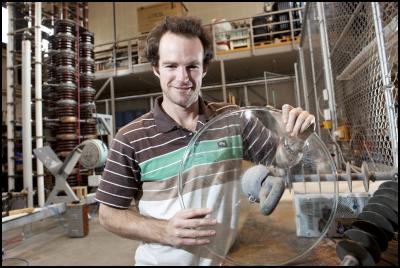Future Eruptions Could Pose Threat To Power Supply
Future Eruptions Could Pose Threat To Power Supply,
Says UC Researcher
October 25, 2012
Future volcanic eruptions could pose threats to New Zealand’s power supply, a University of Canterbury (UC) researcher said today.
UC doctoral student Johnny Wardman said the 1995 Ruapehu volcanic eruption severely disrupted power and a similar eruption could pose a problem again in the future.
Wardman has been looking into the effects of volcanic ash on electric power systems. Several problems arise from volcanic ash contamination on power equipment but the most common problem is insulator flashover.
``Flashover is the, unintended discharge around or across the surface of an insulator. It can be thought of as a large short-circuit. If the resulting short circuit current is high enough to trip the circuit breaker, disruption of service will occur.
``An example of this happening was in 1995 when Ruapehu erupted, raining ash on some 220 kV power lines which lie close to the volcano. This caused voltage fluctuations and problems for electrical equipment throughout the North Island.
``Fluctuations in supply tripped the emergency power at Wellington Hospital, causing non-essential supplies to be shed. Included in this, by accident, was a water pump in one of the hospital's dialysis wings.’’
Wardman said to better understand the problem of ash-induced insulator flashover, he has been running laboratory tests in UC’s high voltage lab to see how high voltage insulators perform when subjected to varying degrees of volcanic ash contamination.
He has been trying to identify the physical, environmental and electrical conditions which contribute most to the flashover mechanism. Results from these tests will strengthen knowledge on the vulnerability of electric power supply to volcanic ash fall hazards.
While there were no concrete solutions to ash fall contamination, there were a number of potential mitigating strategies. The most effective strategy against ash fall impacts was shutting down critical parts of the system such as sub-station and generation facilities until the ash was effectively removed from the immediate area.
Additionally, heightened operational readiness, efficient monitoring and impact assessment of any disruption or damage were key elements of good risk practice. Wardman’s research has been funded by Transpower New Zealand.
Wardman’s supervising lecturer Tom Wilson said there was a huge number of multi-disciplinary natural hazards studies at UC. Collaboration between geological sciences and electrical engineering was a great example, he said.
``With our College of Engineering and College of Science, we can investigate the consequences of natural hazards on critical components and systems.
``This particular research is highly relevant as all of New Zealand's national grid is sited only a few kilometres away from active volcanoes - Ruapehu, Tongaririo and Taranaki. Johnny Wardman is leading the world with his research, with interest from major power companies in the USA and Scandinavia,’’ Dr Wilson said.
Photo: UC student researcher Johnny Wardman

ENDS


 Business Canterbury: Urges Council To Cut Costs, Not Ambition For City
Business Canterbury: Urges Council To Cut Costs, Not Ambition For City Wellington Airport: On Track For Net Zero Emissions By 2028
Wellington Airport: On Track For Net Zero Emissions By 2028 Landcare Research: ANZAC Gall Fly Release Promises Natural Solution To Weed Threat
Landcare Research: ANZAC Gall Fly Release Promises Natural Solution To Weed Threat NZ Anti-Vivisection Society: Auckland Rat Lovers Unite!
NZ Anti-Vivisection Society: Auckland Rat Lovers Unite! University of Canterbury: $1.35 Million Grant To Study Lion-like Jumping Spiders
University of Canterbury: $1.35 Million Grant To Study Lion-like Jumping Spiders Federated Farmers: Government Ends War On Farming
Federated Farmers: Government Ends War On Farming



